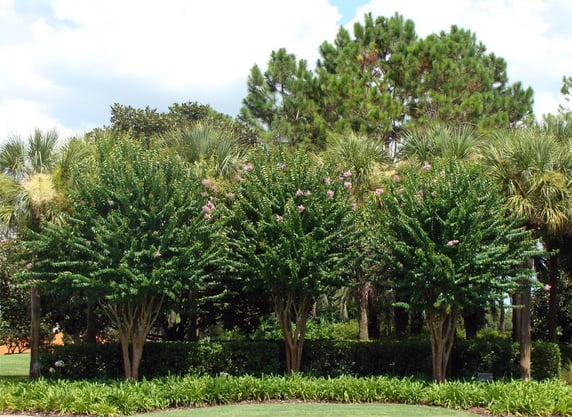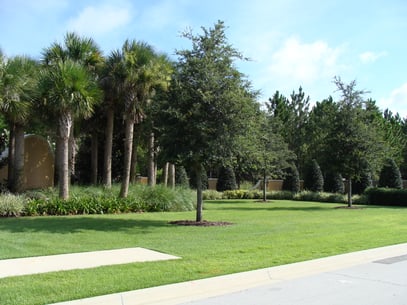
Home / Here on Earth / Landscape Fertilization Plan
Florida boasts of many well-maintained landscapes - they look healthy throughout the year, no matter what season it is. While landscaping involves many aspects, appropriate fertilization is the third principle of Florida-friendly landscaping according to the University of Florida Institute of Food and Agricultural Sciences (UF/IFAS) guidelines.
.png?width=398&name=palm.turf%20(1).png) Plants need nutrients to grow - this is a well-established fact. While the soil has natural nutrients, these need to be supplemented to provide optimal growing conditions for the plants, trees, and grass. This is where the process of fertilization comes into play. It helps fix the soil's nutritional deficiencies while improving the color, texture, and appearance of the plants.
Plants need nutrients to grow - this is a well-established fact. While the soil has natural nutrients, these need to be supplemented to provide optimal growing conditions for the plants, trees, and grass. This is where the process of fertilization comes into play. It helps fix the soil's nutritional deficiencies while improving the color, texture, and appearance of the plants.
Fertilizer Basics
Dry Fertilizer
Dry or granular fertilizer is the most readily available and economical option; it is also easy to apply. It can be scattered over the lawn or applied in rows or rings around individual areas. Before planting, these granules can be spread over the planting area, and after planting, you can side-dress along the rows. Since this is a dry fertilizer, it is recommended to avoid scattering it when the foliage is wet. Water the plants after applying this fertilizer so that the granules dissolve and the soil can absorb the nutrients.
Water Soluble Fertilizer
In water-soluble or liquid fertilizers, liquids containing fertilizer components or crystals are mixed with water and are distributed using a sprinkling can or a spray. The plants are watered first, and once the roots are wet, this liquid fertilizer is applied to the wet soil. The nutrients from this are readily available to the plants and get used up quickly. liquid fertilizers need to be applied more frequently to be effective. Spraying the foliage with a diluted liquid fertilizer is recommended when the plants need a special boost but should not be done too frequently.
Controlled Release or Slow Release Fertilizer
Slow-release or controlled-release fertilizer comes with a coating on the granules that are activated with water or warm temperatures. This allows the fertilizer to be released slowly or in a controlled manner to the soil. Though the effects may take a while to reflect, this kind of fertilizer is the most recommended because it lasts for a long time (approximately 60 days) and hence doesn't need frequent applications. This feature also prevents waste of fertilizer and fertilizer runoffs due to excessive application.
Every fertilizer bag comes with three numbers in bold on it. For example, 12:3:10. This represents the ratio in which the three major components of fertilizer are present.
- The first number (12 in this case) represents Nitrogen (N). Nitrogen promotes shoot growth and keeps your plants looking lush green.
- The second number (3 in this case) represents Phosphorus (P). Phosphorus promotes root growth and cellular functioning of the plant.
- The third number (10 in this case) represents Potassium (K). Potassium promotes root development and increases the endurance aspects of the plants, like disease resistance and stress tolerance.
In Florida, the phosphorus content of the soil is naturally high. Therefore the fertilizer you choose should have low concentrations of Phosphorus. Ideally, a 4:1 ratio of Nitrogen to Phosphorus is recommended. According to Florida state law, Phosphorus should be less than 2%.
Before You Fertilize
Soil tests should always be done before fertilization application. This will indicate the type of soil and inform which nutrients are deficient. When taking a soil sample, it is important to take soil from various areas of the landscape and mix them up, making sure it is pure soil with no grass or mulch in it. If there are different zones in the landscape with varying soil types or plants with varying fertility requirements, then it is recommended to take additional samples.
Sending these for testing to a UF/IFAS Extension office or other commercial laboratories will allow for a report to be created to inform the nutritional deficiencies in the soil and recommend the best fertilizer analysis for the landscape. After receiving the report, it will give a good idea of which fertilizer is best for the landscape.
Best Time To Fertilize Lawn in Florida
The best time to fertilize any lawn is during the growing season. In Florida, grass and most plants remain dormant during the winter months. Fertilizing during the winter months is not recommended as the fertilizer will only be used by weeds to multiply during this time. Once the temperature starts remaining consistently warm (around 55 degrees Fahrenheit) is the time to apply the first fertilizer application of the year. Since Florida is a big state, this timing can vary. For South Florida, this could be as early as mid-February. For central Florida, this could be mid-March, and for North Florida, it could be mid-April.
Most Florida counties have a ban on nitrogen and phosphorus applications from June 1 to September 30. This is called the summertime fertilizer blackout. Check your county ordinance to know if your region is also supposed to follow this ordinance which has been put in place to decrease the nitrate concentrations in Florida waters and improve water quality.
Summer fertilization can be done in May before the fertilizer blackout begins. Fall fertilization that helps in nutrient absorption and keeps the plants ready for growing boost in Spring. The fall fertilization application can be done in October once the blackout ends.
The application of fertilizers is also prohibited 24 hours before heavy rains or when hurricanes are forecasted to prevent fertilizer runoff into surface waters.
Some Other Precautions While Applying Fertilizers
 Apart from some prohibitions mentioned above, other precautions to take while applying fertilizer are:
Apart from some prohibitions mentioned above, other precautions to take while applying fertilizer are:
- Fertilizer should not be applied within 10 feet of a wetland or a water body.
- No Nitrogen fertilizers should be applied for the first 30-60 days after planting for newly planted shrubs or plants.
- Slow-release nitrogen should be applied to provide 1 pound of nitrogen per 1000 feet.
- If any fertilizer spills or falls onto your hardscape area, sweep it into the soil.
- Use a broadcast spreader with a deflector shield to avoid spilling fertilizer on surrounding areas like driveways and water bodies.
- If you use reclaimed water, be careful with the amounts of Nitrogen and Phosphorus in your fertilizer because reclaimed water already has some percentages of these in it.
If you are still unsure about the type of fertilizer to use or the best time to fertilize your landscape, contact Down To Earth Irrigation and Landscaping to answer all your queries and meet the fertilization needs of your landscape.
